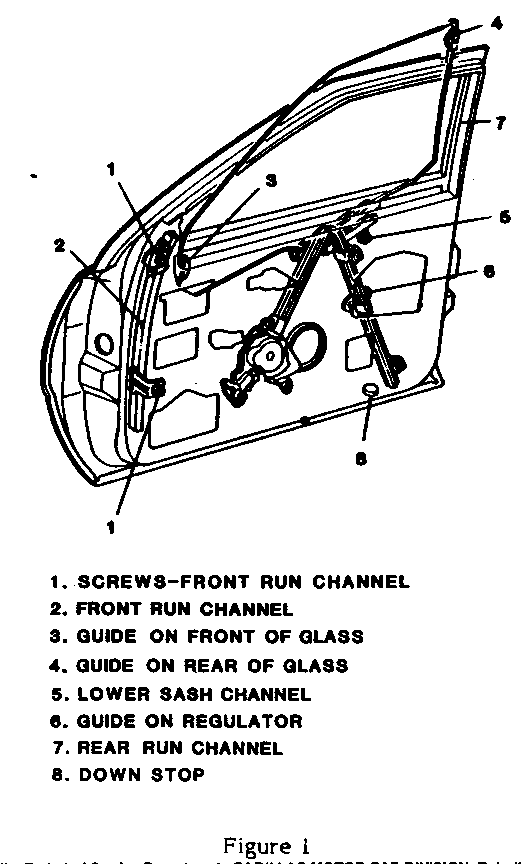FRONT DOOR GLASS INSTALLATION AND ADJUSTMENT

MODELS AFFECTED: 1986 LESABRE 1985-86 ELECTRA
NOTE: This bulletin supersedes Bulletin No. 86-10-9, dated January, 1986. Please discard the original bulletin and replace it with this one.
The 1986 Body Service Manual for the "C" and "H" styles was released without the front door glass adjustment procedure included in the door glass installation procedure. The correct method for installing and adjusting front door glass is as follows (numbers in parenthesis refer to illustration #1):
Install or Connect
1. Front run channel (2) and screws (1) to door, tighten loosely.
2. Glass lower sash channel to guide on regulator by lowering glass into door from outboard side of door frame and rotating glass until the regulator guide is connected to the glass sash channel.
3. Rear guide (4) on glass to rear run channel (7) by pulling back on glass until rear guide snaps into rear run channel.
4. Front guide on glass to front run channel by reaching through front access hole in door inner. Grasp front run channel and snap onto glass guide, pushing front channel rearward until guide snaps into channel.
Adjust
a. Door glass by moving glass upward into door frame header, approximately 5 mm (.20") short of full up position
b. Grasp door glass and move glass rearward to assure full engagement of glass and glass guide pin to glass run channel and retainer, then move glass fully upward into door header. Then run glass fully home into header.
c. Tighten previously loosely installed upper and lower glass run channel retainer screws (1) to specified torque of 9.0 to 12.0 N.m (80 to 106 in-lb).
d. Cycle glass down and to full up position to check operation of glass.
5. Insulator for outside mirror
6. Outside mirror cover
7. Inner belt sealing strip and fillers
8. Trim panel upper retainer
9. Water deflector
10. Trim panel

General Motors bulletins are intended for use by professional technicians, not a "do-it-yourselfer". They are written to inform those technicians of conditions that may occur on some vehicles, or to provide information that could assist in the proper service of a vehicle. Properly trained technicians have the equipment, tools, safety instructions and know-how to do a job properly and safely. If a condition is described, do not assume that the bulletin applies to your vehicle, or that your vehicle will have that condition. See a General Motors dealer servicing your brand of General Motors vehicle for information on whether your vehicle may benefit from the information.
